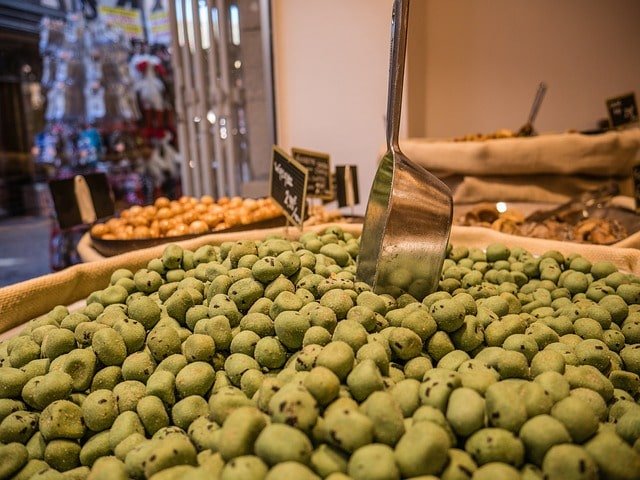
Yes, one can eat wasabi, as it is a food product, a kind of spice that people love due to its specific flavor. People usually consume it along with Sushi in the western world.
Peanuts and other legumes coated with wasabi are also available in some places. Wasabi consumption though not high, but is rising in the US and Europe.
Most people consume it in very small amounts, due to its specific sharp taste, its pungent smell. It is hot in taste, but unlike chilies, it will affect nerve endings in the nose more than taste buds on the tongue.
If someone consumes it in small amounts along with Sushi, it is not only safe but might have some health benefits too. However, like any other food items, excess consumption may have unforeseen effects.
One should avoid consuming too much of it during pregnancy, as most Wasabi served in the US is either fake or has other additives. Thus, it might not be suitable for frequent consumption in pregnancy.
What is wasabi?
Wasabi belongs to the Cruciferae family, which includes mustard, turnip, and even cabbage. Restaurants usually serve Wasabi’s rhizome (root-like part) in the grated form. Its plant achieves a height of about half a meter.
It is one of the most challenging plants to cultivate. It grows naturally near the cold streams among mountains in Japan. It grows at places that have limited sunlight and are not very hot.
Since the plant demands very specific conditions to grow, there are very few places outside Japan where its cultivation is possible.
You might not be consuming real wasabi
For sushi lovers or those who love the flavor of wasabi, it may come as unpleasant news that real wasabi is uncommon even in Japan. Studies estimate that about 95% of wasabi in Japan is fake. However, in the US, perhaps more than 99% of it is fake [1].
Wasabi is one of the most expensive rhizomes, and one kg of it might cost more than 160$ per kg in the wholesale market. Moreover, its production is not enough to meet its demand even to a small degree [2].
One of the reasons why its production is so low is due to the need for specialized technology in its cultivation, requiring very high investments.
There are other problems with natural and real wasabi. It loses its flavor very quickly if not stored properly. Its flavor degrades in just 15 minutes after grating. Thus, only high-end restaurants in the US or Japan might serve real wasabi, where it is freshly grated.
So, what most people around the world are consuming is its imitation. Most commercially available wasabi products or wasabi served in restaurants are created by using horseradish, mustard, and edible green color.
Since European horseradish and mustard are related to wasabi, the taste of this fake wasabi is still very close to the real one.
As, apart from green color, other ingredients are natural, this imitation of wasabi commonly served at various restaurants is safe to consume in small amounts.
Health benefits of wasabi
Wasabi has many health benefits, but only real wasabi. It is rare to use wasabi for managing health conditions due to its high cost.
Some of the well-known health benefits of wasabi are:
- Antibacterial properties– some of the compounds in wasabi like isothiocyanates have potent antibacterial properties, and this may help in many conditions. It may help reduce bacterial growth in the mouth. It can also reduce the risk of foodborne illnesses. It might suppress the growth of H. pylori, a bacterium known to cause peptic ulcer and other gastric issues [3][4].
- Anti-inflammatory properties– low-grade chronic inflammation is regarded particularly bad for health as it increases the risk of many disease conditions like heart disease, diabetes, neurodegenerative diseases, diabetes, mood disorders, and so on. Early research shows that wasabi might suppress inflammation and thus help prevent chronic ailments [5].
- Promotes weight loss– wasabi leaves particularly seem to possess these properties, as they help reduce adipocytes. However, it is not known if such benefits are also characteristic of the rhizome [6].
- Other health benefits– researchers think that it might also help reduce the risk of cancer. Wasabi may also help prevent osteoporosis and thus strengthening them [7]. It may be good news for sushi lovers, as many women are particularly prone to osteoporosis. Additionally, researchers think that wasabi is also suitable for brain health.
Possible health risks for pregnant women
Though health risks of wasabi consumption are almost nil, nevertheless, there is some theoretical risk. The risk may be higher in those consuming wasabi in large amounts.
Pregnant women are prone to heartburn. Wasabi due to its specific flavor may irritate gastric tract a bit and might cause worsening of heartburn in some.
Some women do not tolerate wasabi well. This means that in some rare cases, it might cause gastric distress and even diarrhea [8].
Those with known allergies to wasabi should avoid it. Women prone to diarrhea should also avoid wasabi during pregnancy.
Few risks are less obvious than most might imagine. As already mentioned, 99% of wasabi sold or served in the US is not real but fake. It means that it might have additives that may not be suitable for consumption during pregnancy.
To conclude, Wasabi is safe to consume in pregnancy, and it has no known severe health risks. Moreover, people consume it only in small amounts.
Consuming it in large quantities is not possible due to its bitter flavor. Only women sensitive to it must take precautions.
However, it is vital to understand that finding the real wasabi being served in a restaurant is a rare sight. More than 99% of wasabi is just its imitation.
This fake wasabi is also quite safe; however, some producers may add synthetic additives like green colorants. Thus, eat wasabi sparingly when living with pregnancy.
References
- Taylor K. Wasabi served at most sushi restaurants is not what you think it is. Business Insider. Published January 14, 2017. Accessed July 1, 2020. [Link]
- Gittleson K. Farming “the hardest plant to grow.” BBC News. [Link]. Published September 18, 2014. Accessed July 1, 2020.
- Lu Z, Dockery CR, Crosby M, Chavarria K, Patterson B, Giedd M. Antibacterial Activities of Wasabi against Escherichia coli O157:H7 and Staphylococcus aureus. Front Microbiol. 2016;7:1403. doi:10.3389/fmicb.2016.01403
- Shin IS, Masuda H, Naohide K. Bactericidal activity of wasabi (Wasabia japonica) against Helicobacter pylori. Int J Food Microbiol. 2004;94(3):255-261. doi:10.1016/S0168-1605(03)00297-6
- Uto T, Hou D-X, Morinaga O, Shoyama Y. Molecular Mechanisms Underlying Anti-Inflammatory Actions of 6-(Methylsulfinyl)hexyl Isothiocyanate Derived from Wasabi (Wasabia japonica). Adv Pharmacol Sci. 2012;2012:614046. doi:10.1155/2012/614046
- Oowatari Y, Ogawa T, Katsube T, Iinuma K, Yoshitomi H, Gao M. Wasabi leaf extracts attenuate adipocyte hypertrophy through PPARγ and AMPK. Biosci Biotechnol Biochem. 2016;80(8):1594-1601. doi:10.1080/09168451.2016.1179093
- Yamaguchi M. Regulatory mechanism of food factors in bone metabolism and prevention of osteoporosis. Yakugaku Zasshi. 2006;126(11):1117-1137. doi:10.1248/yakushi.126.1117
- Wasabi | Encyclopedia.com. Published May 22, 2020. Accessed July 1, 2020. [Link]




 Dr. Preet Pal SB is a physician (M.D. Medicine) with a specialization in diabetes (Fellowship in diabetes, Royal Liverpool Academy). He has a particular interest in metabolic disorders, considering that they are rising in every corner of the world, more so in India.
Dr. Preet Pal SB is a physician (M.D. Medicine) with a specialization in diabetes (Fellowship in diabetes, Royal Liverpool Academy). He has a particular interest in metabolic disorders, considering that they are rising in every corner of the world, more so in India.